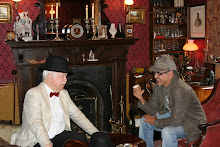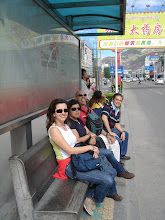Shangai
Shangai is a fantastic example of the capacity to combine of the chinese which, as i said before (see the side bar), is something i truly believe.
Chinese have shown through the years their ability to be patient, learn and take the best of a bad situation. After the Opium wars the english first and then french, american and russians demand some concessions and the control of the sea. The combination of both and the usual facility of the chinese to learn with other cultures and incorporate them as a mode of evolution, made of Shangai a "capitalist" organized system inside feudal (first) and communist (later) society, which has been lasting to our days, as can be illustrated with the first appearance in china of railway, post office, elevator, tap water, car, trolley, film projection, bank, gas lamp, telephone, gramophone or department store, etc. Today´s is the economical capital of China, motor of development, innovation of the country and recently the main door of comunication with the outside world (due to its strategic position near by China sea).
I always thought of tea as a refined social drink, such it is the Port wine for we portuguese. And so i travelled around with my companions trying to find a place for an unique moment with that within our stay in the city. And we just ended up in a nice tea house located in the Old Town's Yuyuan Garden, near the Ziga-zag bridge, after visiting the City God's Temple. And i knew that i was right, it is really a refined drink which creates a refined moment.
To be representing the combined soul of shangai i combined western music (Hard to Concentrate, Red Hot Chili Peppers) with traditional chinese's.
See you next week for Pudong and Shangai´s night.
Shangai é o perfeito exemplo da capacidade de combinar que os chineses revelam na sua cultura, e que como sabem é uma acção muito grata para mim (ver a barra lateral do blog). Após as guerras do ópio, os britanicos primeiro e depois franceses, russos e americanos reclamaram direitos sobre propriedade e fronteiras portuárias instalando um sistema ocidental capitalista no seio de uma china feudal (primeiro) e comunista depois. Mesmo durante o period mais isolado da china maoista, Shangai sempre gozou de autonomia para gerir o seu próprio destino, fornecendo à restante china condições para harmonização do seu sistema comunista com o mundo actual. Os primeiros aparecimentos em toda a china do primeiro banco, carro, comboio, telefone, elevador, trolley, posto dos correios, projecção pública de filme, lãmpadas a gás, gramofone, etc deram-se em Shangai. Hoje Shangai é a Capital económica da china, motor de desenvolvimento, inovação e a principal porta de comunicação com o mundo actual, devido à sua posição priveligiada junto ao mar da China.
Eu sempre senti o chá como uma bebida requintada, tal como o Vinho do Porto é para a minha gente, de modo que vagueei por Shangai com os meus companheiros de viagem, à procura de um local apropriado para beber uma chávena de chá em ambiente especial. E assim desaguamos numa espantosa casa de chá, no Yuyuan Garden na Old Town, ao pé da Zig-Zag bridge, depois de uma visita oa City God Temple. Um Requinte.
Para estar de acordo com este enquadramento escolhi um mix de ocidente (Hard to Concentrate dos Red Hot Chili Peppers) com a china (musica tradicional chinesa).
Até para a semana com o Pudong e Shangay by night.
.jpg)



